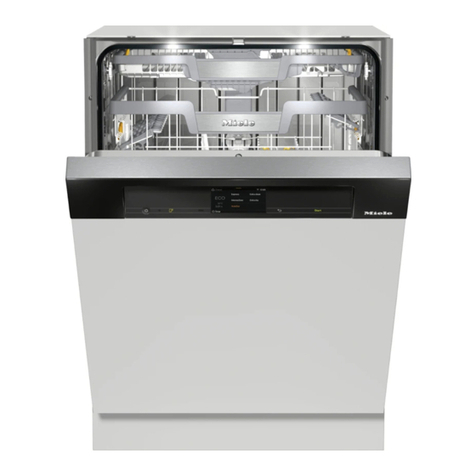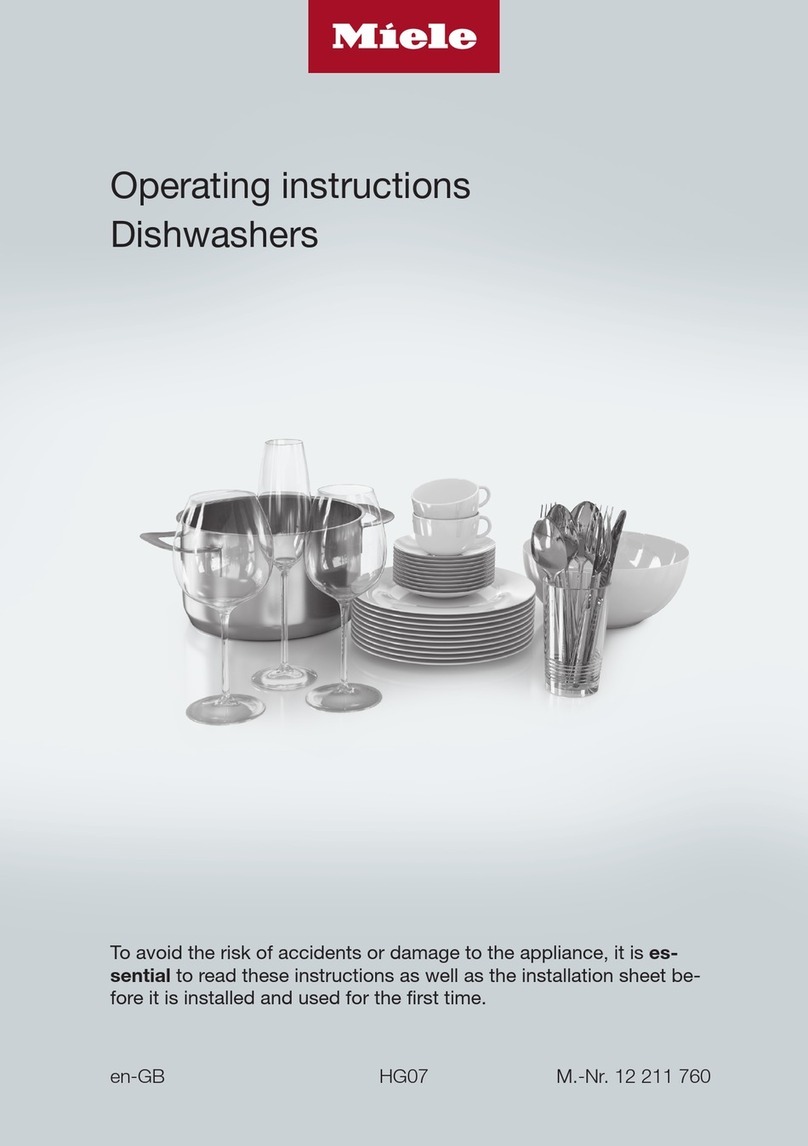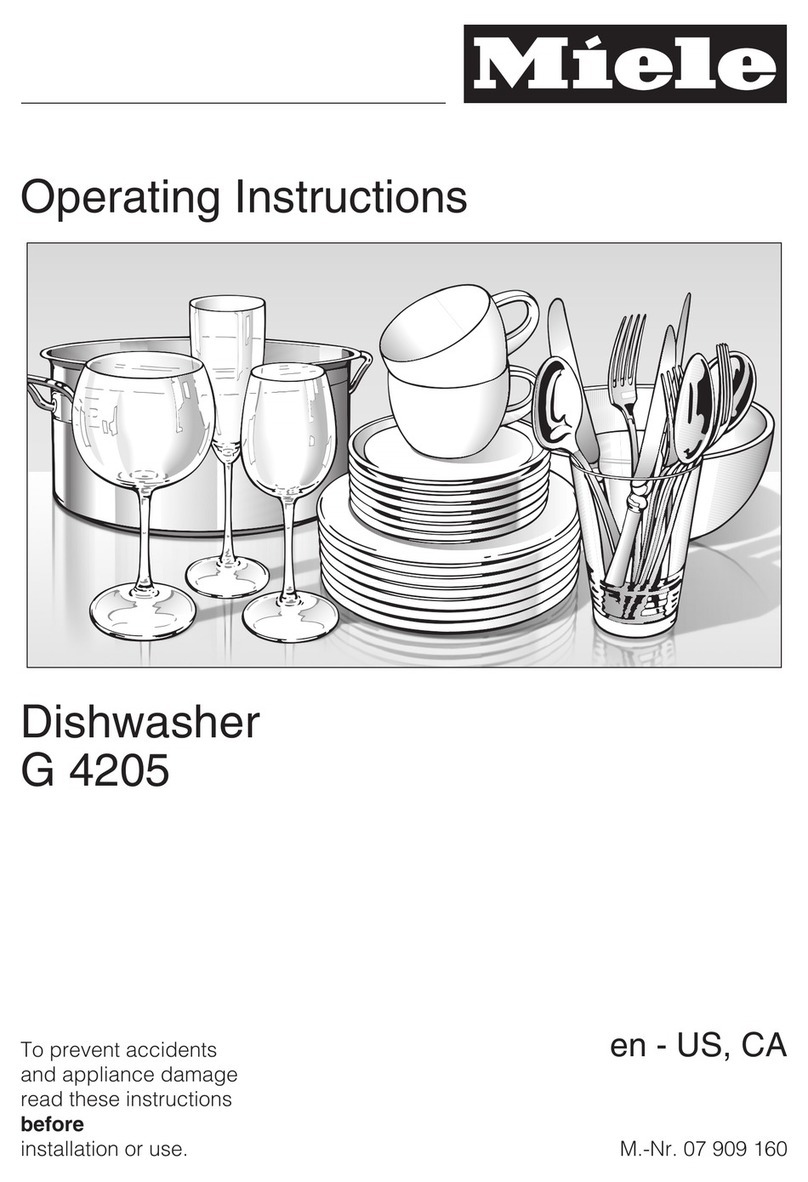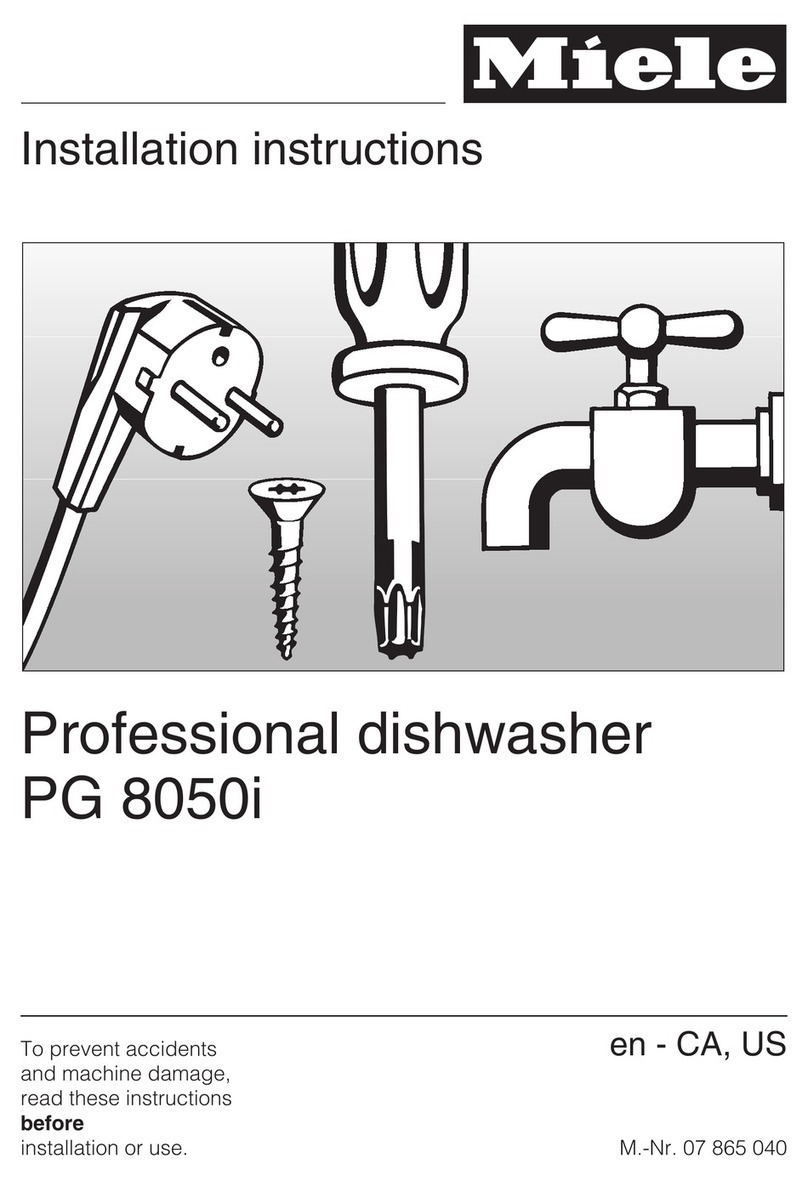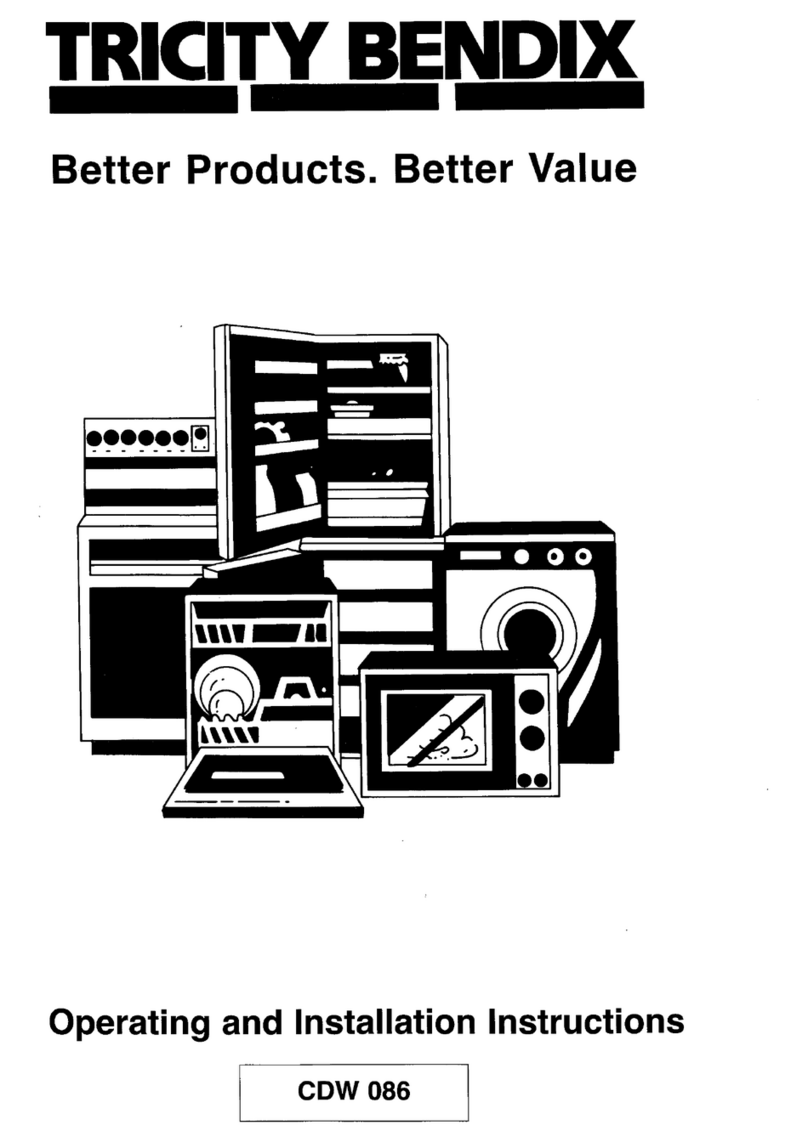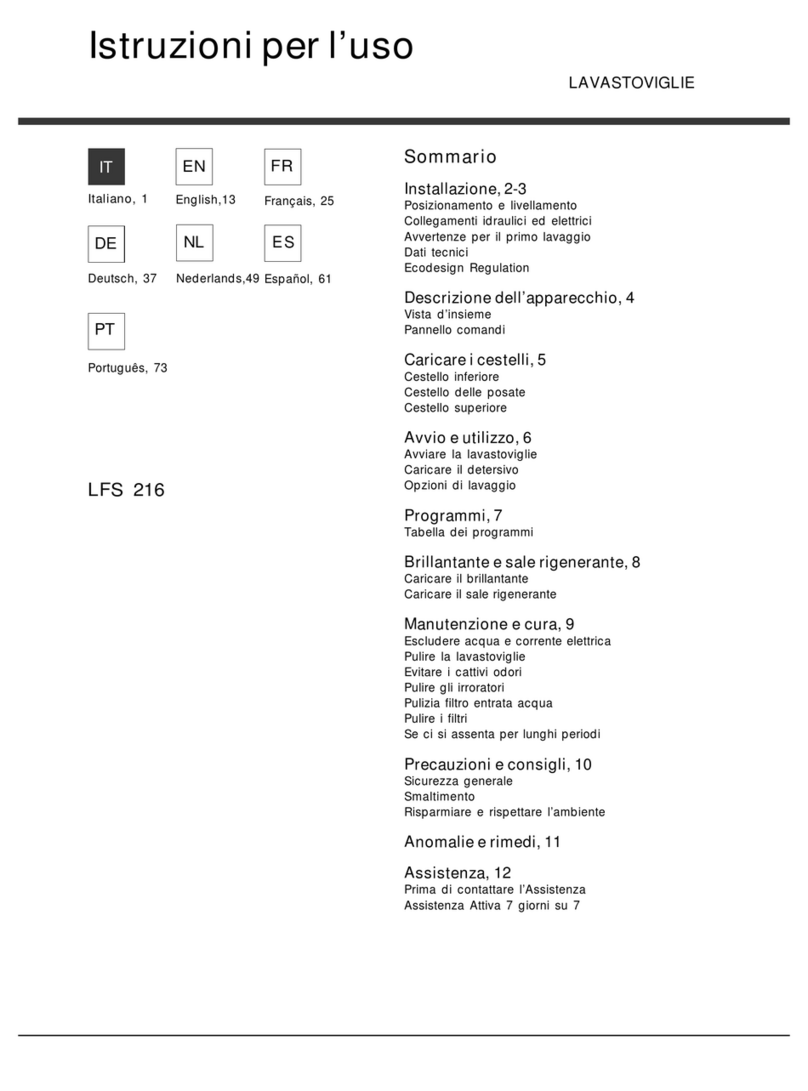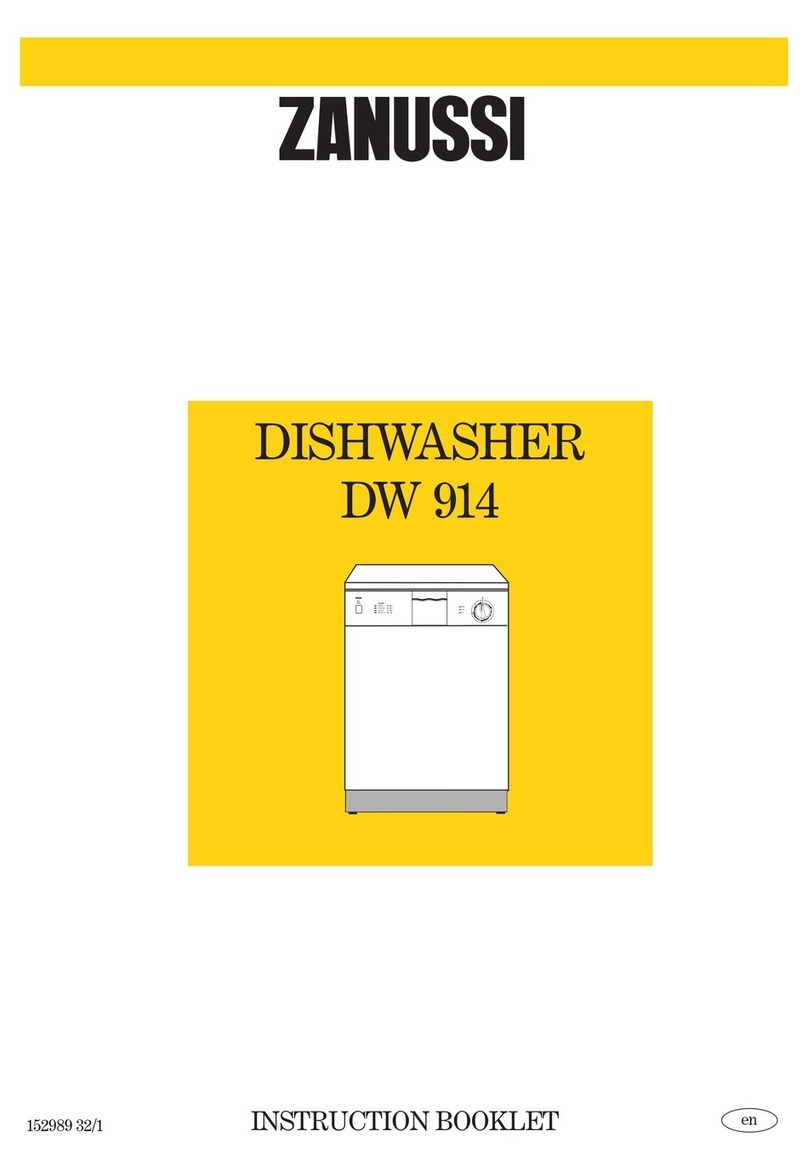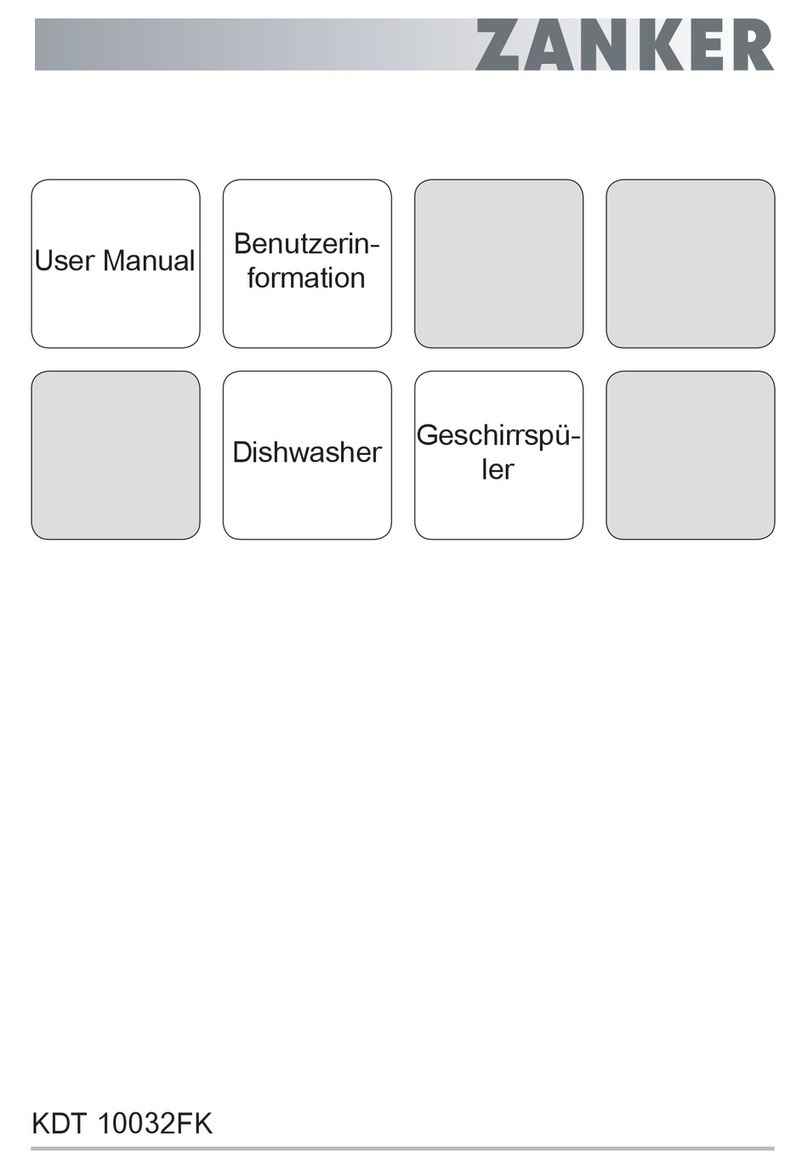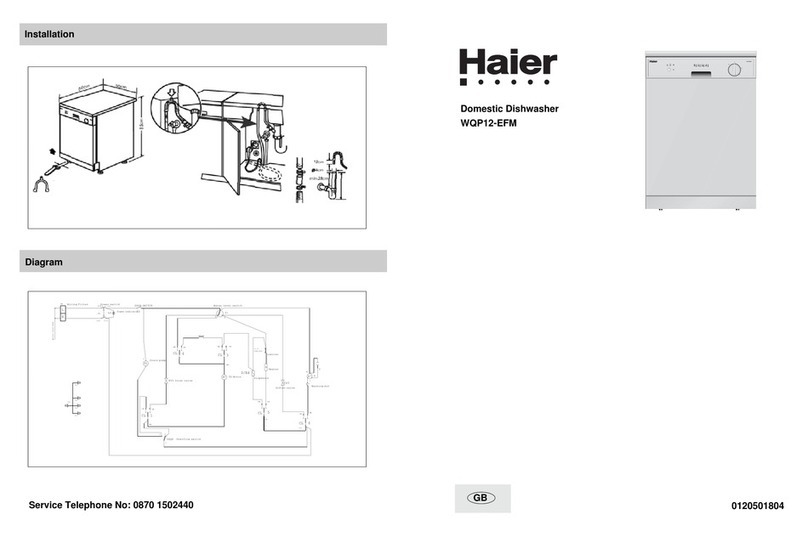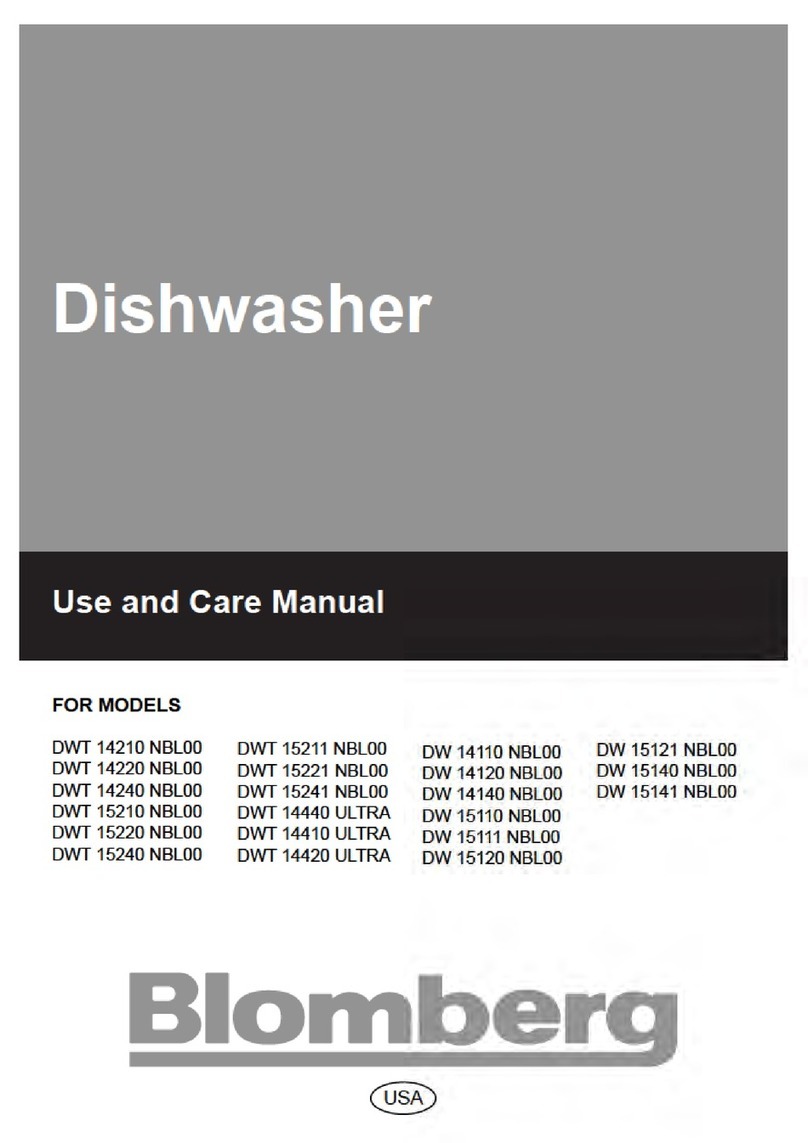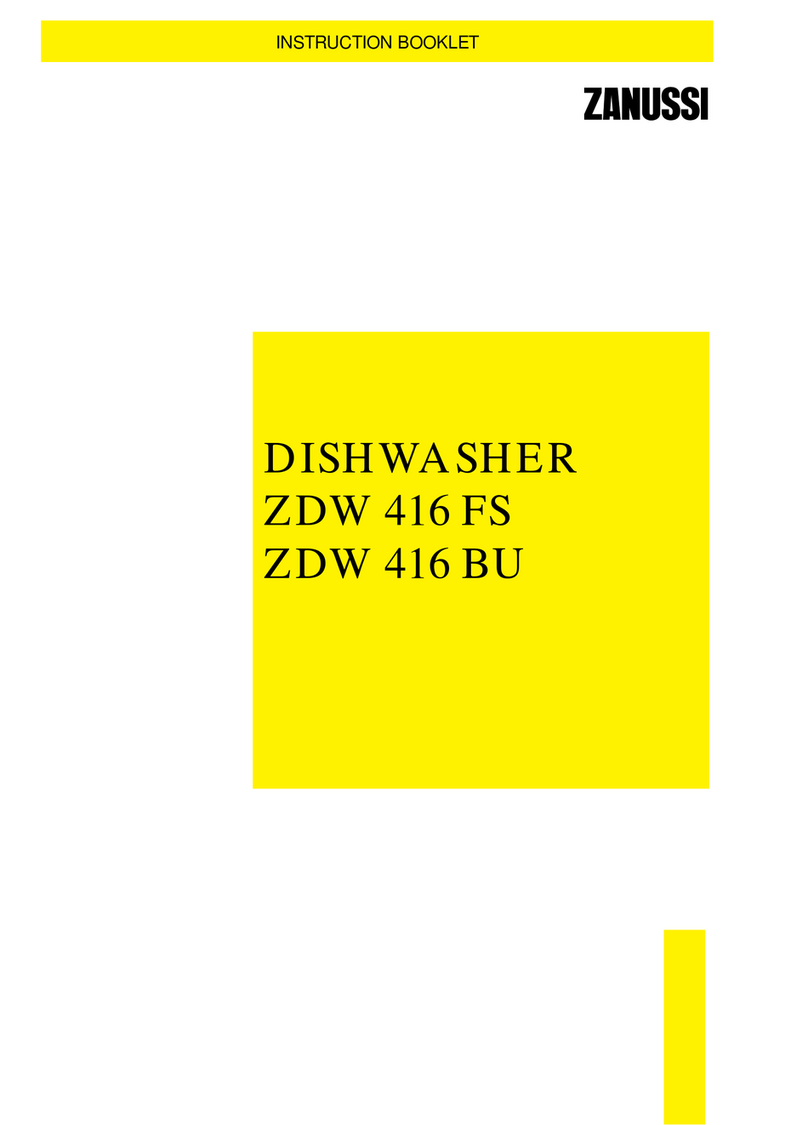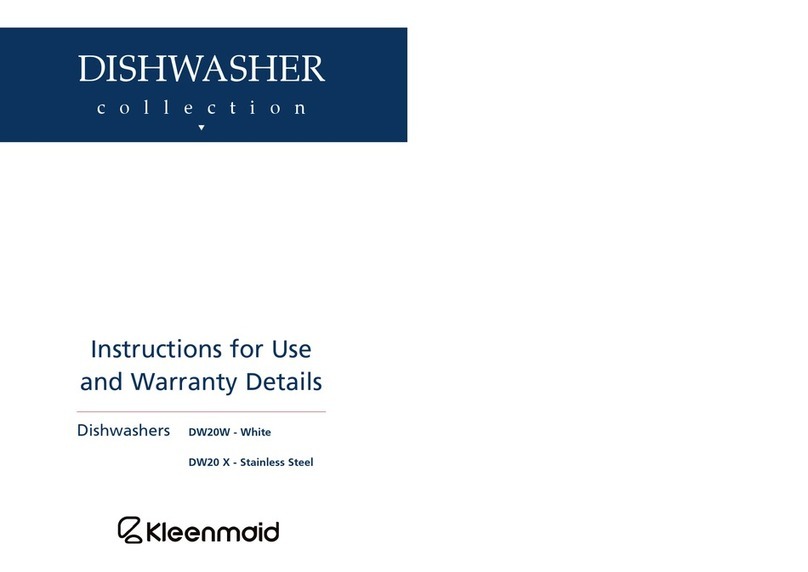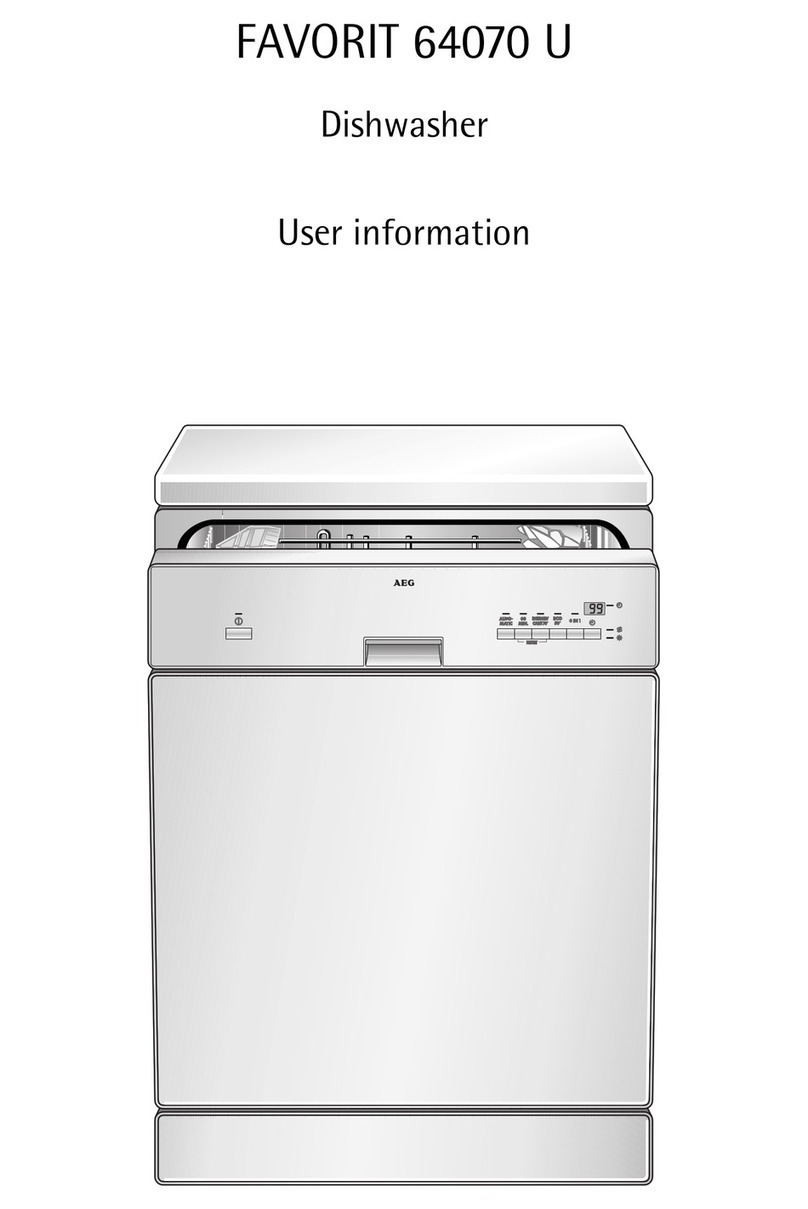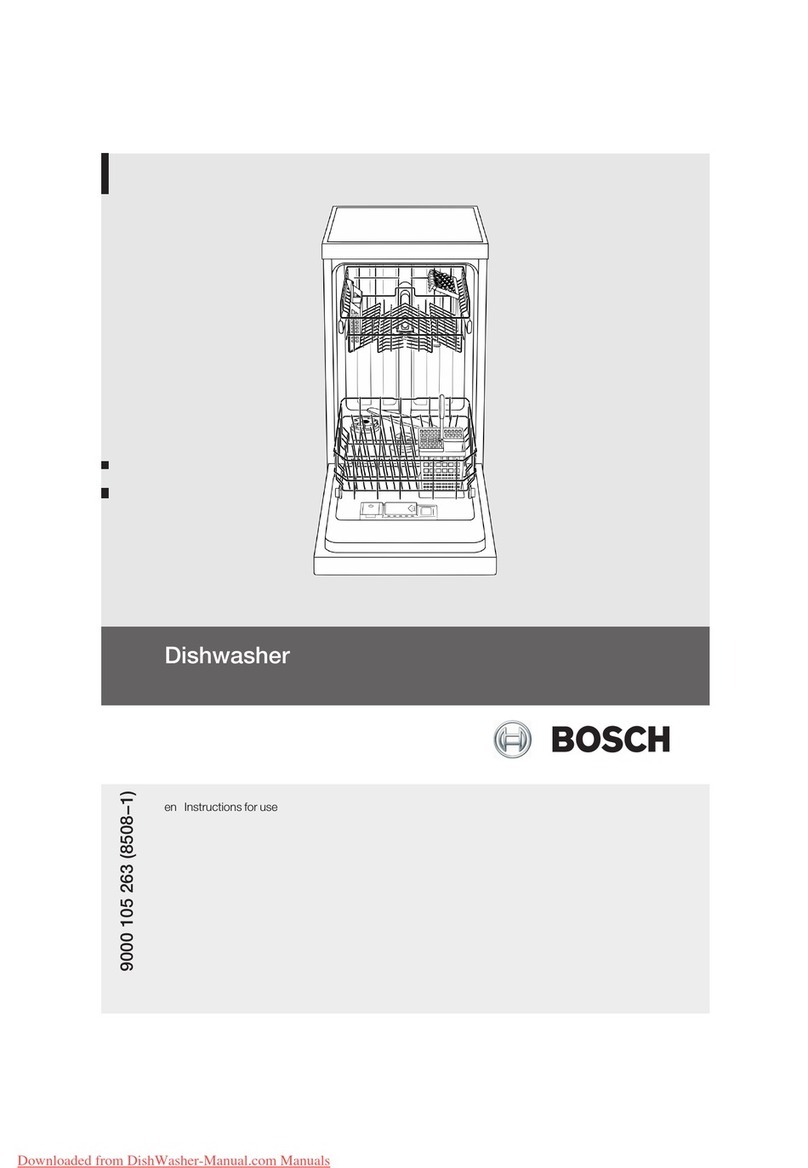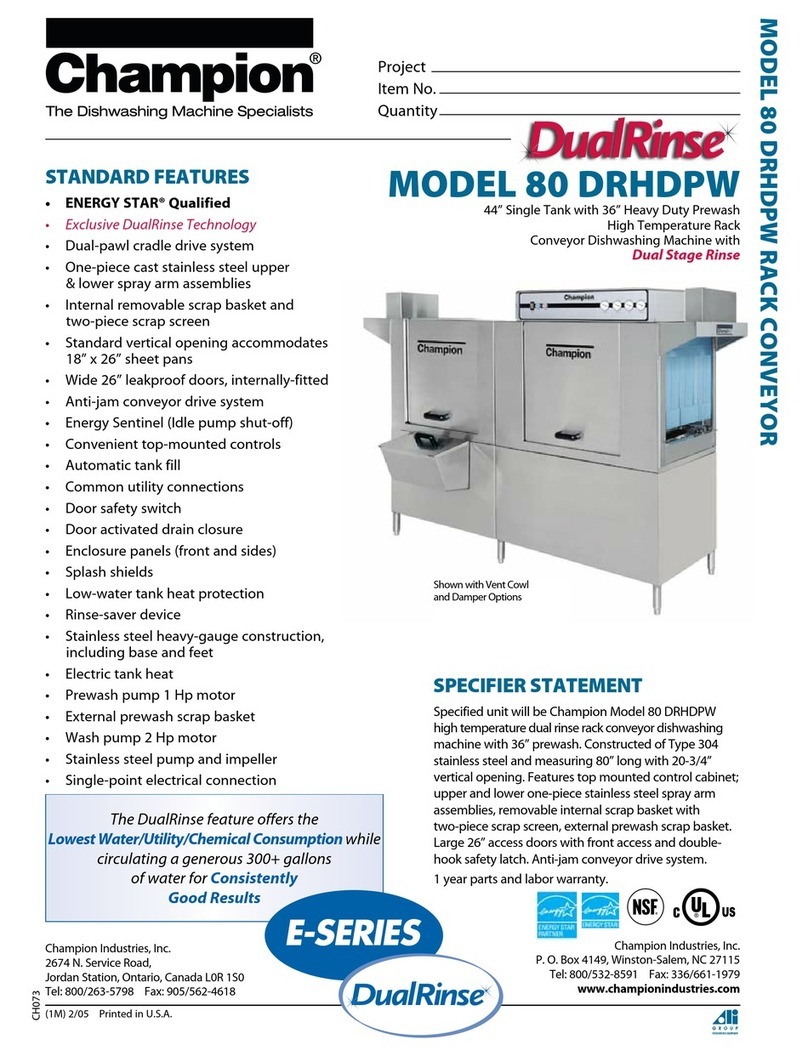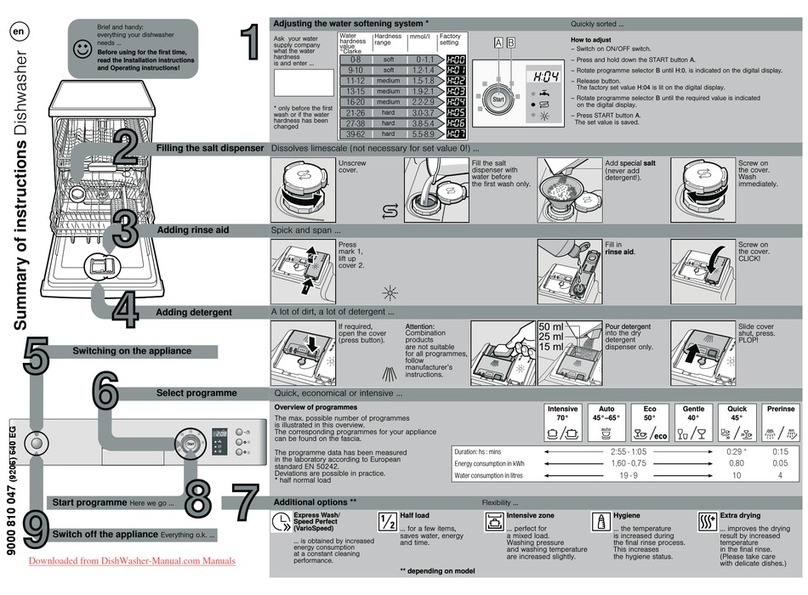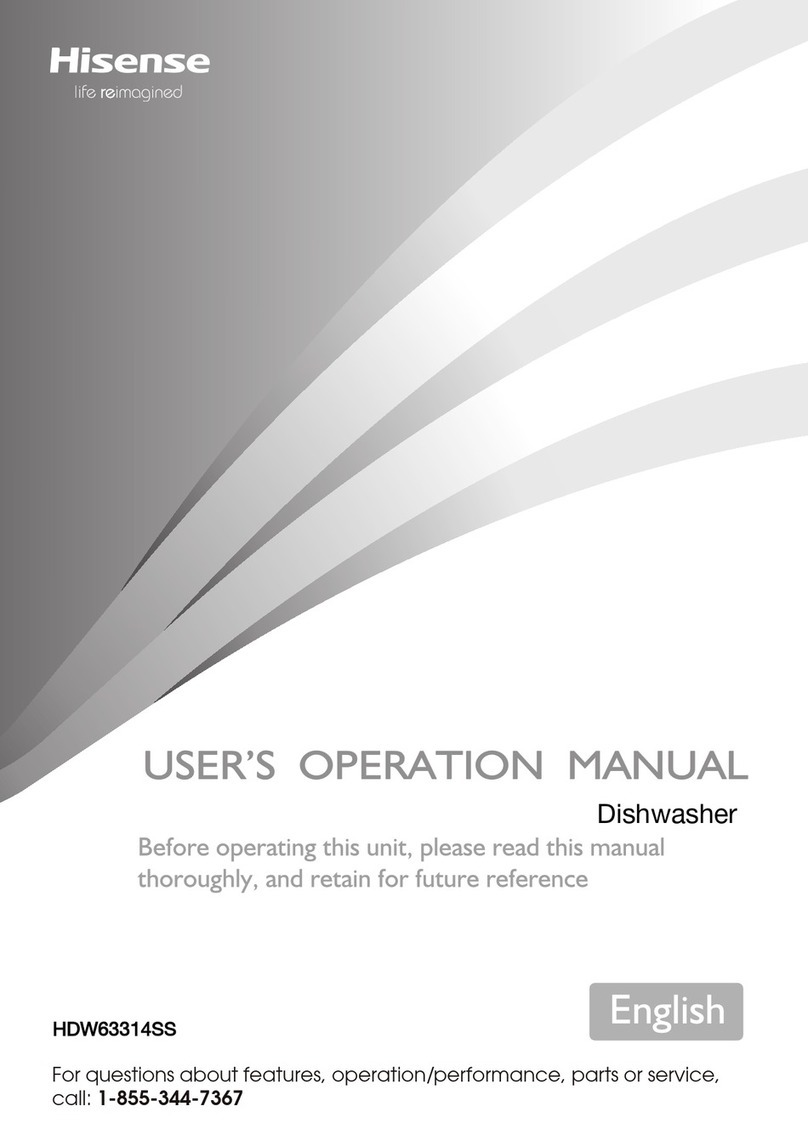Miele G 1542 User manual

Operating instructions
for dishwashers
To avoid the risk of accidents or
damage to the appliance, it is
essential to read these instructions
as well as the installation plan before
it is installed and used for the
first time. M.-Nr. 06 992 161
en-GB

Guide to the appliance . . . . . . . . . . . . . . . . . . . . . . . . . . . . . . . . . . . . . . . . . . . . . 5
Appliance overview .................................................5
Control panel ......................................................6
Warning and Safety instructions . . . . . . . . . . . . . . . . . . . . . . . . . . . . . . . . . . . . . 7
Caring for the environment. . . . . . . . . . . . . . . . . . . . . . . . . . . . . . . . . . . . . . . . . 12
Disposal of the packing material ......................................12
Disposal of your old appliance .......................................12
Energy saving washing .............................................13
Before using for the first time. . . . . . . . . . . . . . . . . . . . . . . . . . . . . . . . . . . . . . . 14
To open the door ..................................................14
To close the door ..................................................14
Safety lock .......................................................14
Before using the appliance for the first time you require: ...................15
To call up the water hardness level in the display.........................15
External water softening system ......................................16
Filling the salt reservoir .............................................17
Salt indicator .....................................................19
Rinse aid ........................................................20
Adding rinse aid ..................................................20
Rinse aid indicator .................................................21
Setting the rinse aid dosage .........................................22
Loading the dishwasher . . . . . . . . . . . . . . . . . . . . . . . . . . . . . . . . . . . . . . . . . . . 23
Items not suitable for dishwashers: ....................................24
Upper basket .....................................................25
Removable spiked insert .........................................25
Hinged cup rack ................................................26
Positioning rail (depending on model) ...............................26
Support rail ....................................................27
Adjusting the upper basket .......................................28
Lower basket .....................................................29
Vario inserts ...................................................29
Bottle holder ...................................................30
Cutlery ..........................................................31
Cutlery tray (depending on model)..................................31
Cutlery basket (depending on model) ...............................32
Contents
2

Operation . . . . . . . . . . . . . . . . . . . . . . . . . . . . . . . . . . . . . . . . . . . . . . . . . . . . . . . 33
Detergent ........................................................33
Adding detergent..................................................34
Switching on .....................................................35
Selecting a programme .............................................35
Starting a programme ..............................................35
Time display......................................................36
Glass care indicator................................................36
Programme sequence indicators .....................................36
At the end of a programme ..........................................36
Switching off .....................................................37
Unloading the dishwasher ...........................................37
Interrupting a programme ...........................................37
Changing a programme ............................................37
Additional functions . . . . . . . . . . . . . . . . . . . . . . . . . . . . . . . . . . . . . . . . . . . . . . 38
Extra options .....................................................38
Turbo.........................................................38
Combi tabs ....................................................38
Delay start .......................................................39
Factory default setting ..............................................41
Adjust Sensor wash ................................................42
Cleaning and care . . . . . . . . . . . . . . . . . . . . . . . . . . . . . . . . . . . . . . . . . . . . . . . . 43
Cleaning the wash cabinet ..........................................43
Cleaning the door and the door seal ...................................43
Cleaning the door front .............................................43
Checking the filters in the wash cabinet ................................44
Cleaning the filters .................................................44
Cleaning the spray arms ............................................46
Problem solving guide . . . . . . . . . . . . . . . . . . . . . . . . . . . . . . . . . . . . . . . . . . . . 47
Technical problems ................................................47
Water inlet / drain fault ..............................................49
General problems .................................................50
Noises ..........................................................52
Unsatisfactory washing result ........................................53
Maintenance . . . . . . . . . . . . . . . . . . . . . . . . . . . . . . . . . . . . . . . . . . . . . . . . . . . . . 56
Cleaning the water inlet filter .........................................56
Cleaning the drain pump and non-return valve...........................57
Contents
3

Programme chart . . . . . . . . . . . . . . . . . . . . . . . . . . . . . . . . . . . . . . . . . . . . . . . . . 58
After sales service . . . . . . . . . . . . . . . . . . . . . . . . . . . . . . . . . . . . . . . . . . . . . . . . 60
Repairs .......................................................60
Future updates .................................................60
For testing institutes................................................60
Optional accessories. . . . . . . . . . . . . . . . . . . . . . . . . . . . . . . . . . . . . . . . . . . . . . 61
Electrical connection. . . . . . . . . . . . . . . . . . . . . . . . . . . . . . . . . . . . . . . . . . . . . . 62
Plumbing. . . . . . . . . . . . . . . . . . . . . . . . . . . . . . . . . . . . . . . . . . . . . . . . . . . . . . . . 63
The Miele waterproof anti-leak system .................................63
Connection to the water supply .......................................63
Drainage ........................................................64
Technical data . . . . . . . . . . . . . . . . . . . . . . . . . . . . . . . . . . . . . . . . . . . . . . . . . . . 65
Contents
4

Appliance overview
aUpper spray arm (not visible)
bCutlery tray (depending on model)
cUpper basket
dMiddle spray arm
eAir inlet for drying
(depending on model)
fLower spray arm
gFilter combination
hData plate
iChild safety lock in door grip (not
visible)
jRinse aid reservoir
kDual compartment detergent
dispenser
lSalt reservoir
Guide to the appliance
5

Control panel
aProgrammes
bGlass care indicator
cTime display
dExtra options with indicator lights
eProgramme sequence indicators
fOn/Off button K
gCheck/Refill indicators
hStart/Stop button with indicator light
iDelay start button
with indicator light
jExtra options button
kProgramme selector button
This instruction book applies to several different dishwasher models.
The specific dishwasher models below are referred to as follows:
G 1542, G 1552 etc. = G 1XXX
G 2542, G 2552 etc. = G 2XXX
The model numbers G 1XXX and G 2XXX used in this book refer to the model
designation specified on the data plate of the appliance (and not the
description on the control panel).
The data plate is located at the top right hand side of the door.
Guide to the appliance
6

This appliance conforms to current
safety requirements. Inappropriate
use can, however, lead to personal
injury and damage to property.
To avoid the risk of accidents and
damage to the appliance, please
read these instructions carefully
before using it for the first time. They
contain important information on its
safety, use and maintenance.
Keep these instructions in a safe
place and pass them on to any
future owner.
Correct application
~This dishwasher is intended
exclusively for cleaning domestic
crockery and cutlery in a domestic
household. Using it for purposes other
than those for which it was designed,
as well as any alterations or
conversions to the appliance, would be
unauthorised and could cause harm.
The manufacturer cannot be held liable
for damage resulting from improper or
incorrect use of the appliance.
~This dishwasher is not intended for
use by persons (including children)
with reduced physical, sensory or
mental capabilities, or lack of
experience and knowledge, unless they
are supervised whilst using it or they
have been given instruction concerning
its use by a person responsible for their
safety.
Safety with children
~This appliance is not a toy! To avoid
the risk of injury, keep children well
away and do not allow them to play in
or around the dishwasher, or to use the
controls. They will not understand the
potential dangers posed by it. They
should be supervised whenever you
are working in the kitchen. There is a
danger that children playing might shut
themselves in the dishwasher.
~Older children may only use the
dishwasher when its operation has
been clearly explained to them and
they are able to use it safely,
recognising the dangers of misuse.
~Keep children away from
detergents. Dishwasher detergents
contain irritant and corrosive
ingredients which can cause burning in
the mouth, nose and throat if
swallowed, or inhibit breathing. Keep
children away from the dishwasher
when the door is open. There could still
be detergent residues in the cabinet.
Consult a doctor immediately if your
child has swallowed or inhaled
detergent.
Warning and Safety instructions
7

Technical safety
~Before setting up the appliance,
check it for any externally visible
damage. Under no circumstances
should you use a damaged appliance.
A damaged appliance could be
dangerous.
~The dishwasher must only be
plugged into the electricity supply via a
suitable switched socket. The electrical
socket must be easily accessible after
the dishwasher has been installed so
that it can be disconnected from the
electricity supply at any time. (See
"Electrical connection").
~There must be no electrical sockets
behind the dishwasher. Danger of
overheating and fire risk if the
dishwasher were to be pushed up
against a plug.
~The dishwasher must not be
installed under a hob. The high radiant
temperatures which are sometimes
generated by a hob could damage the
dishwasher. For the same reason it
should not be installed next to open
fires or other appliances which give off
heat, such as heaters etc.
~Do not connect the dishwasher to
the mains supply until it has been fully
installed.
~Before connecting the appliance,
check that the connection data on the
data plate (voltage and connected
load) match the mains electricity
supply. If in any doubt, consult a
qualified electrician.
~The electrical safety of this
appliance can only be guaranteed
when continuity is complete between it
and an effective earthing system. It is
most important that this basic safety
requirement is present and regularly
tested and where there is any doubt the
electrical system in the house should
be checked by a qualified electrician.
The manufacturer cannot be held liable
for the consequences of an inadequate
earthing system (e.g. electric shock).
~Do not connect the appliance to the
mains electricity supply by a
multi-socket unit or an extension lead.
These do not guarantee the required
safety of the appliance (e.g. danger of
overheating).
Warning and Safety instructions
8

~This equipment may only be
installed in mobile installations such as
ships if a risk assessment of the
installation has been carried out by a
suitably qualified engineer.
~The plastic housing of the water
connection contains an electrical
component. The housing must not be
dipped in water.
~There are live wires in the water inlet
hose. Never cut the water inlet hose,
even if it is too long.
~The integrated Waterproof System
offers protection from water damage,
provided the following conditions are
met:
– The dishwasher is correctly installed
and plumbed in.
– The dishwasher is properly
maintained and parts are replaced
where it can be seen that this is
necessary.
–The stopcock has been turned off
when the appliance is not used for a
longer period of time (e.g. during
holidays).
The Waterproof system will work even if
the appliance is switched off. However,
the appliance must remain connected
to the electricity supply.
~A damaged appliance could be
dangerous. If the dishwasher gets
damaged, switch it off at the mains and
call your Miele Dealer or the Miele
Service Department.
~Unauthorised repairs could result in
unforeseen dangers for the user, for
which Miele cannot accept liability.
Repairs should only be undertaken by a
Miele approved service technician.
~Faulty components must only be
replaced by genuine Miele original
spare parts. The manufacturer can only
guarantee the safety of the appliance
when Miele replacement parts are
used.
~Always disconnect the dishwasher
from the electrical supply for
maintenance work (switch off at the wall
socket and remove the plug).
~If the connection cable is damaged
it must be replaced with a Miele cable
by a Miele approved service technician
only.
~In countries where there are areas
which may be subject to infestation by
cockroaches or other vermin, pay
particular attention to keeping the
appliance and its surroundings in a
clean condition at all times. Any
damage which may be caused by
cockroaches or other vermin will not be
covered by the guarantee.
Warning and Safety instructions
9

Installation
~The dishwasher must be installed
and connected in compliance with the
installation instructions.
~The dishwasher must be correctly
aligned to ensure problem-free
operation.
~In order to ensure stability,
built-under and integrated dishwashers
must only be installed under a
continuous worktop which is secured to
adjacent cabinetry.
~If you want to convert your
freestanding dishwasher to a
built-under ("U") model, you will need to
order the appropriate conversion kit. If
you remove the existing plinth, you
must replace it with a U-model plinth.
This is necessary to avoid the risk of
injury caused by protruding metal
parts.
Correct use
~Do not use solvents in the
dishwasher. Danger of explosion.
~Do not inhale or ingest dishwasher
detergent. Dishwasher detergents
contain irritant or corrosive ingredients
which can cause burning in the nose,
mouth and throat if swallowed, or inhibit
breathing. Consult a doctor immediate-
ly if detergent has been swallowed or
inhaled.
~Avoid leaving the door open
unnecessarily, as you could trip over it.
~Do not sit or lean on the opened
door. This could cause the dishwasher
to tip and be damaged, and you could
get injured.
~Only use detergent and rinse aid
formulated for domestic dishwashers.
Do not use washing-up liquid.
~Do not use commercial or industrial
detergents as these may cause
damage, and there is a risk of severe
chemical reaction.
~Do not fill the rinse aid reservoir with
powder or liquid detergent. This will
cause serious damage to the reservoir.
Warning and Safety instructions
10

~Inadvertently filling the salt reservoir
with powder or liquid dishwasher
detergent will damage the water
softener. Make sure you have picked
up the correct packet of dishwasher
salt before filling the salt reservoir!
~Please only use special coarse
grained dishwasher salt for reactivation,
as other salts may contain insoluble
additives which can impair the
functioning of the softener.
~In an appliance with a cutlery basket
(depending on model) cutlery is
cleaned and dried more efficiently if
placed in the basket with the handles
downwards. However, to avoid the risk
of injury, place knives and forks etc.
with the handles upwards.
~Plastic items which cannot withstand
being washed in hot water, such as
disposable plastic containers, or plastic
cutlery and crockery should not be
cleaned in the dishwasher. The high
temperatures in the dishwasher may
cause them to melt or lose shape.
~On models with "Delay start", make
sure that the dispenser is dry before
adding detergent. Wipe dry if
necessary. Detergent will clog if poured
into a damp dispenser and may not be
thoroughly dispersed.
Accessories
~Only use genuine Miele spare parts
and accessories with this appliance. If
spare parts or accessories from other
manufacturers are used, this will
invalidate the guarantee, and Miele
cannot accept liability.
Disposal of your old
dishwasher
~Make the door lock inoperative so
that children cannot accidentally shut
themselves in. Make appropriate
arrangements for the disposal of the
appliance.
The manufacturer cannot be held
liable for damage caused by
non-compliance with these Warning
and Safety instructions.
Warning and Safety instructions
11

Disposal of the packing
material
The transport and protective packing
has been selected from materials which
are environmentally friendly for disposal
and can normally be recycled.
Ensure that any plastic wrappings,
bags, etc. are disposed of safely and
kept out of the reach of babies and
young children. Danger of suffocation.
The packaging consists of the following
materials:
Outer packaging:
– Corrugated cardboard made from up
to 100% recyclable material,
or: Polyethylene (PE) shrink wrap
– Polyproplylene (PP) strapping
Inner packaging:
– Chlorine and fluorine free expanded
polystyrene (EPS)
–Base, lid frame and support battens
made from untreated natural wood
from renewable forests.
–Polyethylene (PE) protective wrap
Rather than just throwing these
materials away, please ensure they are
recycled.
Disposal of your old appliance
Electrical and electronic appliances
often contain materials which, if
handled or disposed of incorrectly,
could be potentially hazardous to
human health and to the environment.
They are, however, essential for the
correct functioning of your appliance.
Please do not therefore dispose of your
old appliance with your household
waste.
Please dispose of it at your local
community waste collection/recycling
centre and ensure that it presents no
danger to children while being stored
for disposal.
To enable sorting by type of plastic for
recycling, all plastic parts of the
appliance are labelled with international
standard symbols.
Caring for the environment
12

Energy saving washing
This dishwasher is exceptionally
economical in its use of water and
electricity. You can make the most of
your appliance by following these tips:
^If your household water system is
suitable, this dishwasher can be
connected to a hot water supply for
further economies. If the water is
heated by for example, solar panels,
this would be energy efficient.
However, if your water is heated by
electricity we would recommend
connection to cold water.
^For most economical dishwashing,
make full use of the baskets without
overloading the dishwasher.
^Choose the programme to suit the
type of crockery being washed and
the degree of soiling.
^Select the Energy save programme
for energy-saving dishwashing.
^Follow the detergent manufacturer's
recommendations on detergent
dosage.
^When using powder or liquid
detergent, you can use 1/3less
detergent if baskets are only half full.
Caring for the environment
13

To open the door
^Press the release catch inside the
door grip upwards and pull the door
open.
If the door is opened during operation
all functions are automatically
interrupted.
To close the door
^Push the baskets right in.
^Then lift the door upwards and push
until it clicks into position.
Safety lock
Use the safety lock to prevent children
opening the dishwasher door.
^To lock the door, push the slide
underneath the door grip to the right.
^To unlock the door, push the slide to
the left.
Before using for the first time
14

Before using the appliance for
the first time you require:
–Approx. 1 kg dishwasher salt*,
–Domestic dishwasher detergent*,
–Rinse aid* formulated for domestic
dishwashers.
* Miele branded products are
available from the Miele Spare Parts
Department or via the internet at
www.miele-shop.com.
Every dishwasher is tested at the
factory.
There will be residual water in the
appliance from this test. It is not an
indication that it has been used
previously.
This dishwasher is fitted with a water
softener sensor which automatically
sets the water softener unit for the
local water hardness level.
To call up the water hardness
level in the display
After your dishwasher has been
through one programme cycle, you can
check the water hardness level
measured by the water softener sensor
in the display.
This is shown in °d - German scale, and
can fluctuate depending on the quality
of the water.
^Switch the dishwasher off using the
On/Off button K.
^Press the Start/Stop button in and
whilst holding it in switch the
dishwasher on using the the On/Off
button K.
Keep the Start/Stop button pressed in
until the Start/Stop indicator comes
on.
If this does not happen, start the
procedure from the beginning again.
^Press the Delay start button six times.
The Delay start indicator will flash
briefly six times at intervals.
The number after the pin the display is
the water hardness level in °d.
^Switch the dishwasher off using the
On/Off button K.
Before using for the first time
15

External water softening
system
If your dishwasher is connected to an
external water softening system which
uses salt to reactivate, you will still need
to programme the dishwasher to the
correct water hardness level to achieve
good cleaning results.
Set the water softener unit of the
dishwasher to the water hardness level
of the water which is supplied from the
external water softening system.
If you do not know what it is, set the
dishwasher for 8 °d (1.4 mmol/l).
^Switch the dishwasher off using the
On/Off button K.
^Press the Start/Stop button in and
whilst holding it in switch the
dishwasher on using the On/Off
button K.
Keep the Start/Stop button pressed in
until the Start/Stop indicator comes
on.
If this does not happen, start the
procedure from the beginning again.
^Press the Delay start button twice.
The Delay start indicator will flash
briefly twice at intervals.
The number after the pin the display is
the water hardness level in °d.
^Use the Start/Stop button to select
the value which equates to the water
hardness level of the water supplied
by the external water softening
system.
Each press on the button moves you
up a level. When the highest water
hardness level is reached, the setting
starts from the beginning again.
^Switch the dishwasher off using the
On/Off button K.
If you disconnect the dishwasher
from the external water softening
system, set the value to P0.
Before using for the first time
16

Filling the salt reservoir
In order to achieve good cleaning
results, the dishwasher needs to
operate with soft water. Hard water
results in the build-up of calcium
deposits on crockery and in the
dishwasher.
Mains water with a hardness level
higher than 0.7 mmol/l (4 °d – German
scale) needs to be softened. This takes
place automatically in the integrated
softener unit.
The softener unit is suitable for a water
hardness level of up to 12.6 mmol/l
(70 °d). It requires dishwasher salt.
If you use combination products
which have salt in them in your
dishwasher, such as "3 in 1" or
"4 in 1" products, you should still
add salt in order to achieve optimum
results and to ensure that the water
softener continues to function
correctly. Selecting the Combi tabs
option reduces salt consumption to
between 1/3and 1/4of the normal
amount.
If the water in your area is very soft
and constantly lower than
0.7 mmol/l (4 °d) you should still
add salt before using the
dishwasher for the first time. Salt
should only be replenised when the
salt indicator light comes on. In
areas with very soft water this could
be after a long period of time.
,Inadvertently filling the salt
reservoir with powder or liquid
dishwasher detergent will damage
the water softener. Make sure you
have picked up the correct packet
of dishwasher salt before filling the
salt reservoir!
,Only use special coarse grained
dishwasher salt for reactivation. Do
not use other salts such as cooking
salt, agricultural grade or gritting
salt. These may contain insoluble
additives which can impair the
functioning of the water softener.
Before using for the first time
17

^When filling the salt reservoir only
open the door halfway to ensure
that all the salt gets into the reservoir.
^Press the button on the lid of the salt
reservoir in the direction of the arrow
until the flap springs open.
^Lift up the funnel.
Do not fill the salt reservoir with
water.
^Add salt only until the reservoir is full
or until water runs out of the opening.
The salt reservoir holds approx. 1 kg
of salt, depending on the brand
used.
Do not add any more than 1 kg of
salt.
As the salt reservoir is filled, displaced
water may overflow.
^Clean any excess salt from around
the reservoir opening, and then close
the flap.
^Run the Quick wash programme im-
mediately (without any crockery in
the dishwasher, and without selecting
the Turbo extra option) to remove any
traces of salt from the cabinet.
Before using for the first time
18

Salt indicator
^Fill the salt reservoir with dishwasher
salt when the salt indicator light
comes on. (If it comes on during a
programme, wait until the end of the
programme).
After the reservoir has been filled, the
water softener is automatically
reactivated the next time the
dishwasher is run. The salt refill
indicator may still be illuminated during
this process. It will go out once the salt
concentration has reached the correct
level.
,After filling the salt reservoir, run
the Quick wash programme immedi-
ately (without any crockery in the
dishwasher, and without selecting
the Turbo extra option) to remove
any traces of salt from the cabinet.
Miele branded dishwasher salt is
available from the Miele Spare Parts
Department or via the internet at
www.miele-shop.com.
Before using for the first time
19

Rinse aid
Rinse aid is necessary to ensure water
does not cling and leave marks on
crockery during the drying phase and
helps crockery dry faster after it has
been washed.
Rinse aid is poured into the storage
reservoir and the amount set is
dispensed automatically.
,Inadvertently filling the rinse aid
reservoir with powder or liquid
detergent will damage the reservoir.
Only pour rinse aid formulated for
domestic dishwashers into the
reservoir.
Miele branded rinse aid is available
from the Miele Spare Parts
Department or via the internet at
www.miele-shop.com.
Alternatively, it is possible to use
–Household vinegar with a max. 5%
acid content
or
–Liquid citric acid up to 10% acid
content.
The resulting rinsing and drying quality
will not, however, be as good as when
rinse aid is used.
,Do not use vinegar with a higher
acid content (e.g. vinegar essence
25% acid). This would damage the
dishwasher.
If you only ever use combination
products in your dishwasher, you do
not need to add rinse aid.
Adding rinse aid
^Press the button on the lid of the
rinse aid reservoir in the direction of
the arrow until the flap springs open.
Before using for the first time
20
This manual suits for next models
5
Table of contents
Other Miele Dishwasher manuals
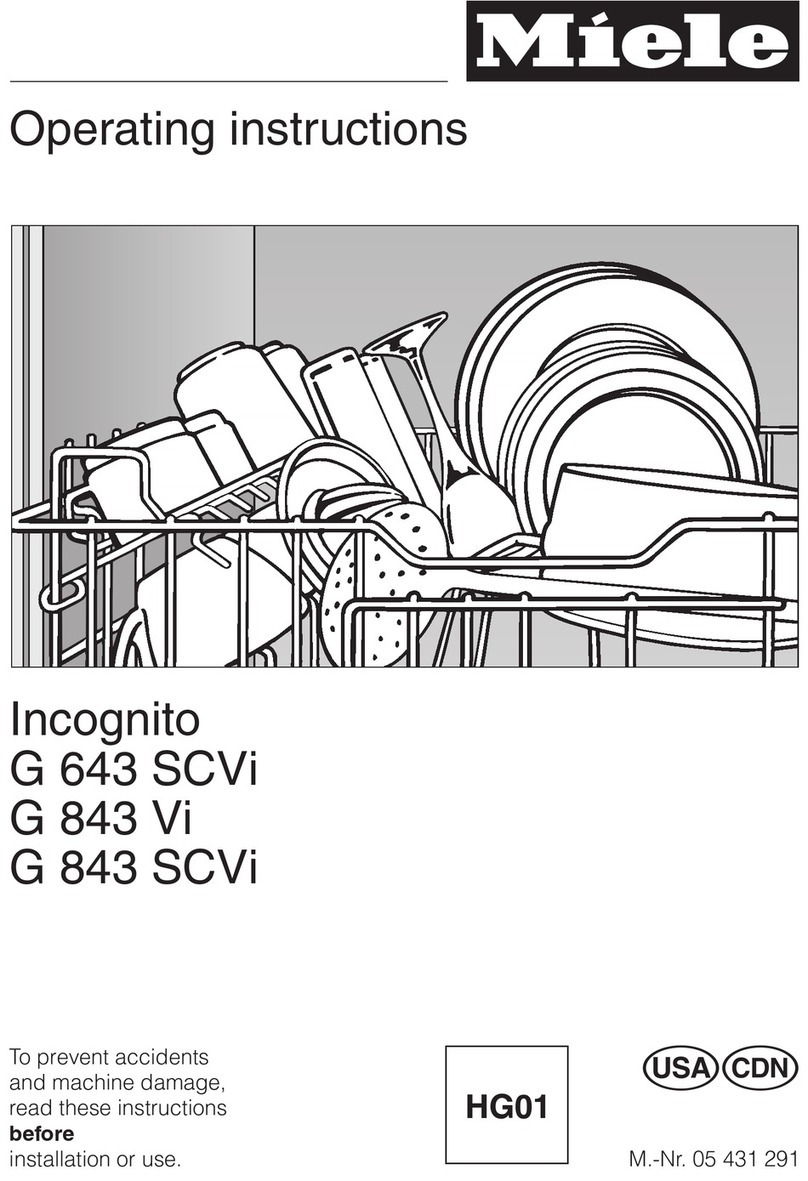
Miele
Miele Incognito G 643 SCVi User manual

Miele
Miele PFD 104 SCVi User manual

Miele
Miele G 2732 User manual
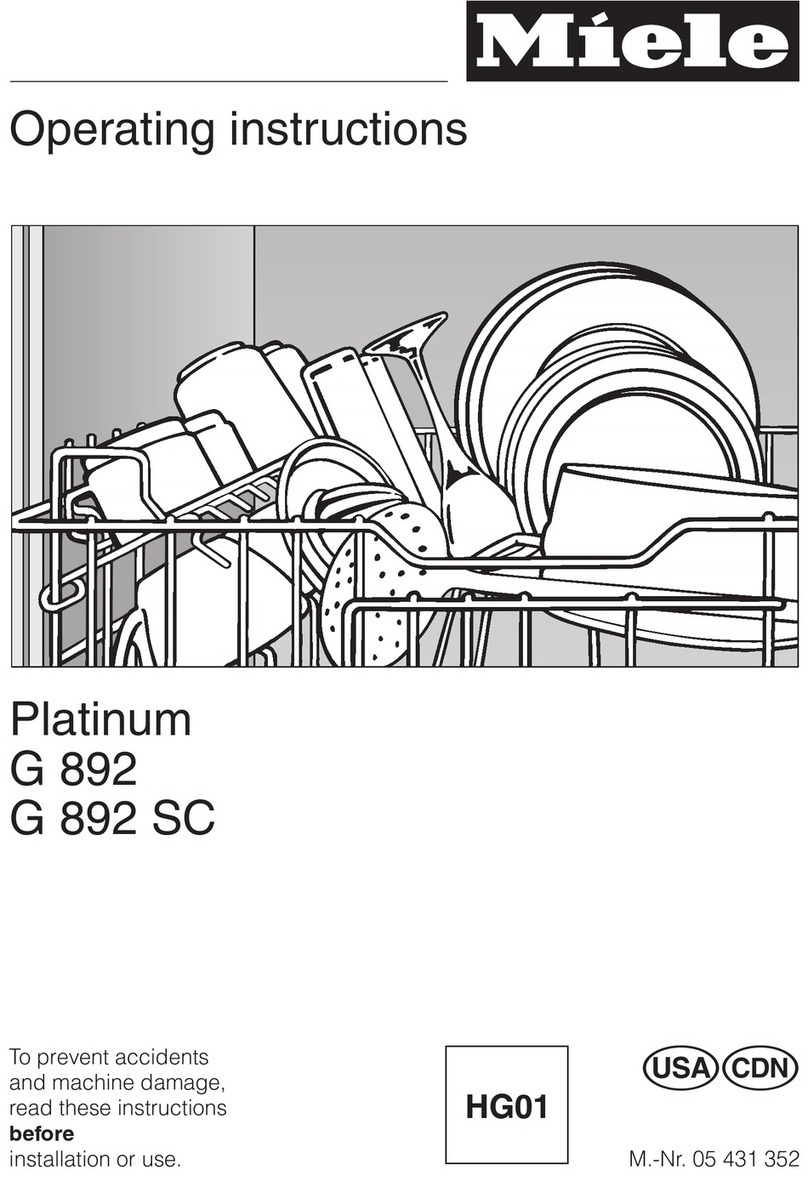
Miele
Miele Platinum G 892 User manual
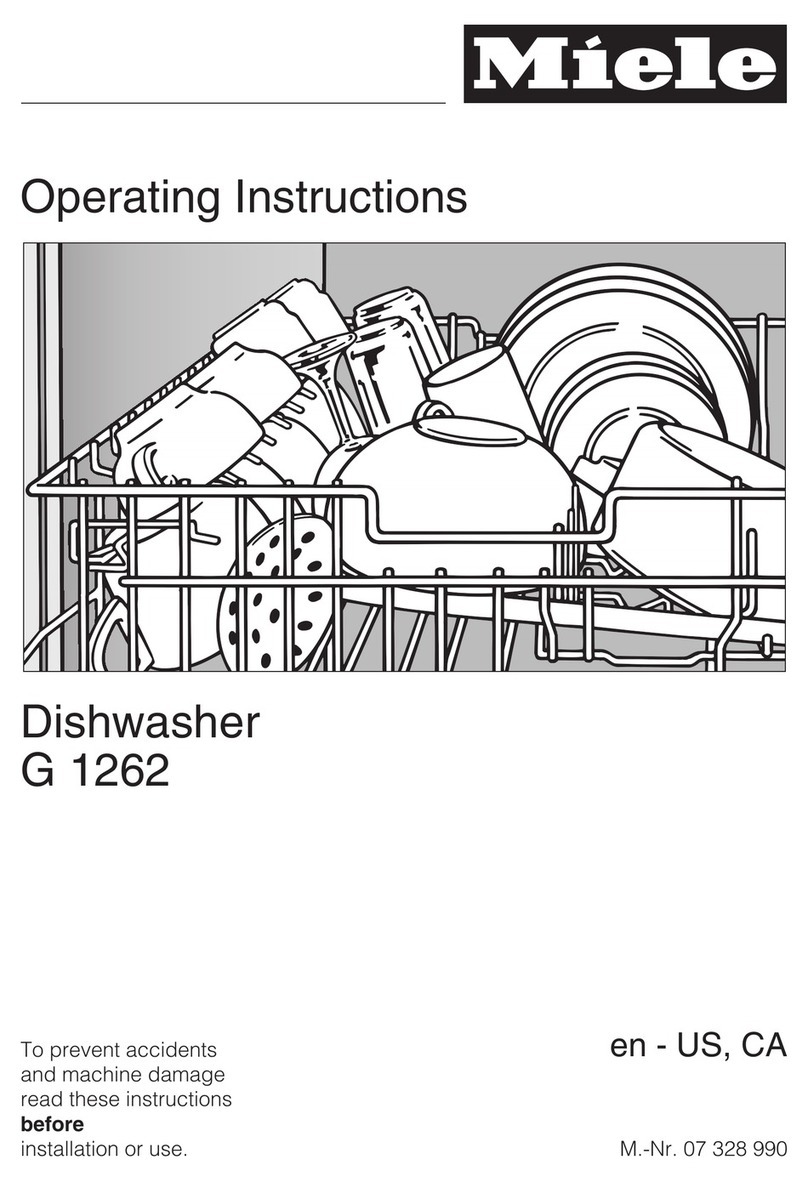
Miele
Miele G 1262 User manual

Miele
Miele PFD 100 User manual

Miele
Miele G 7314 User manual
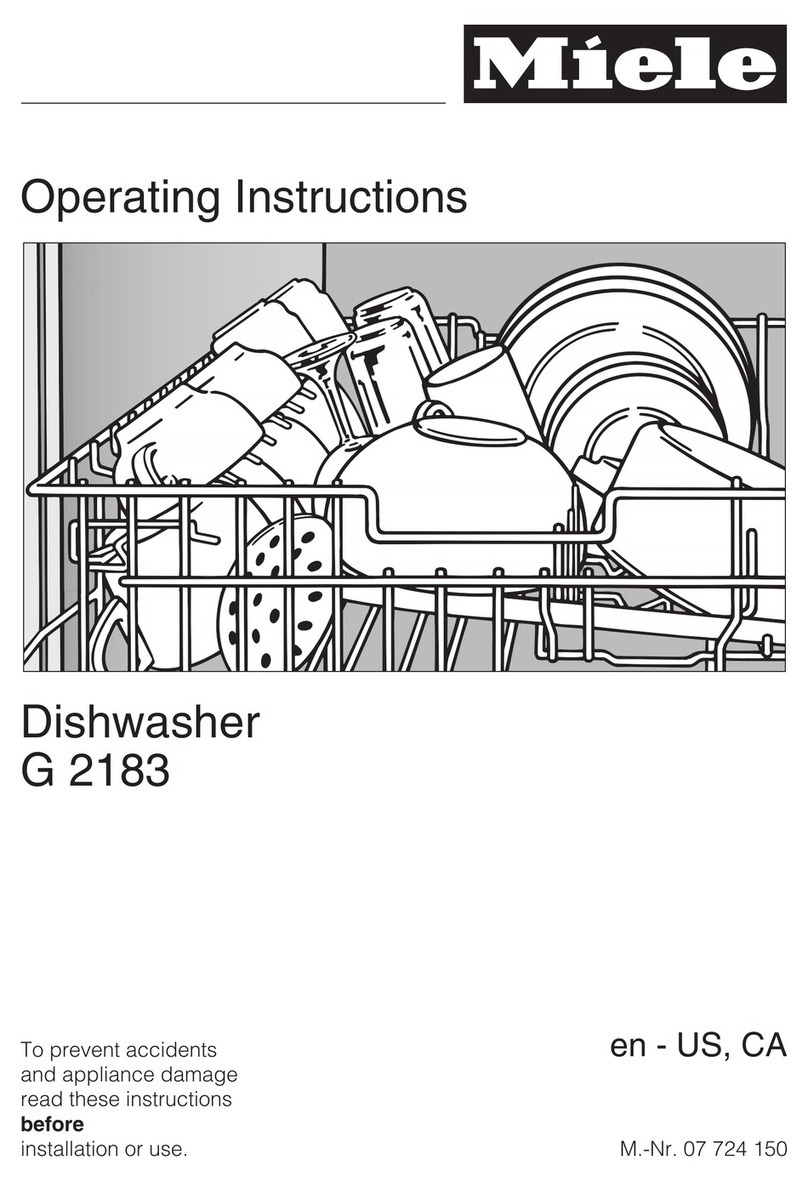
Miele
Miele Diamante Plus G2183SCVI User manual
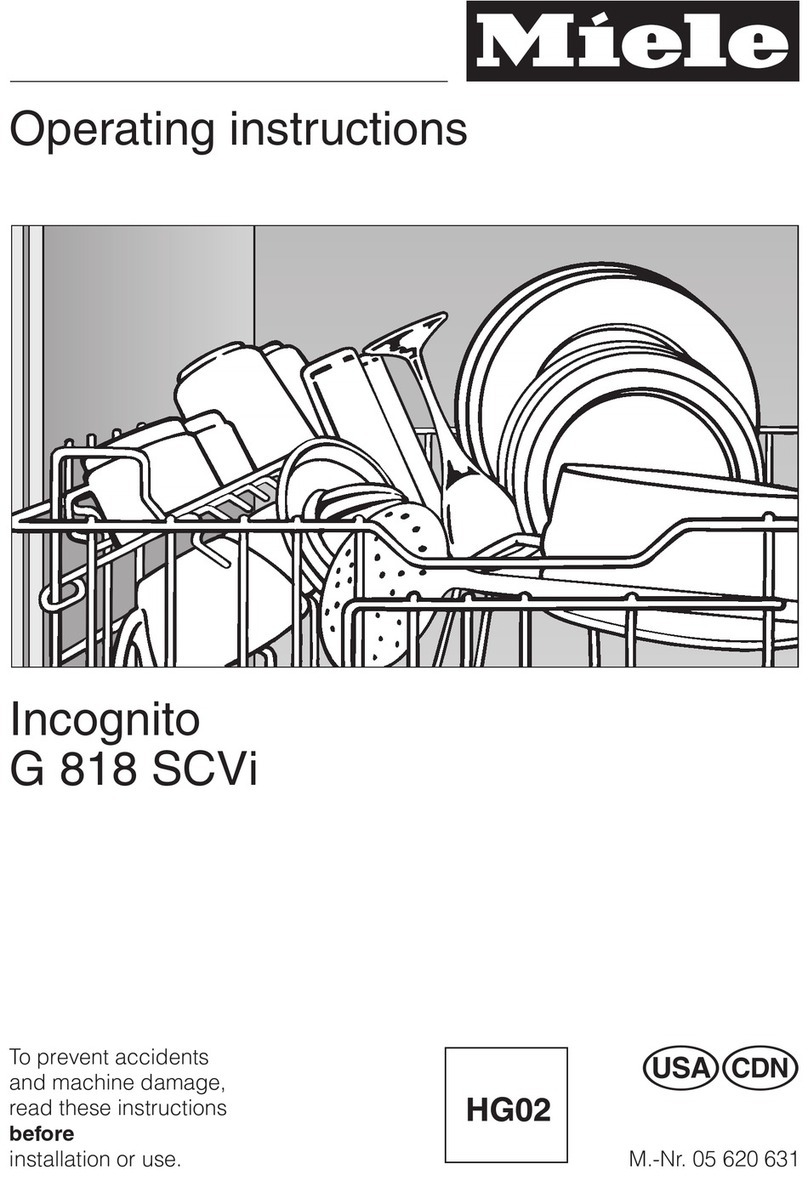
Miele
Miele Incognito G 818 SCVi User manual
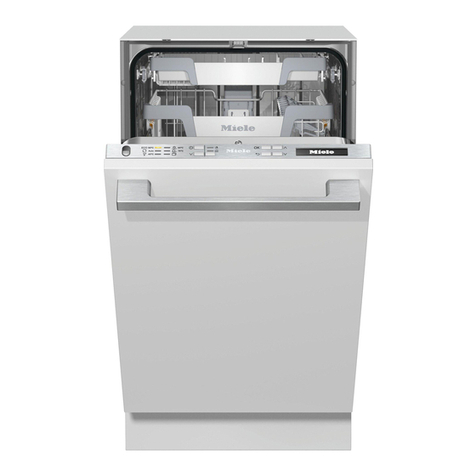
Miele
Miele HG07 User manual
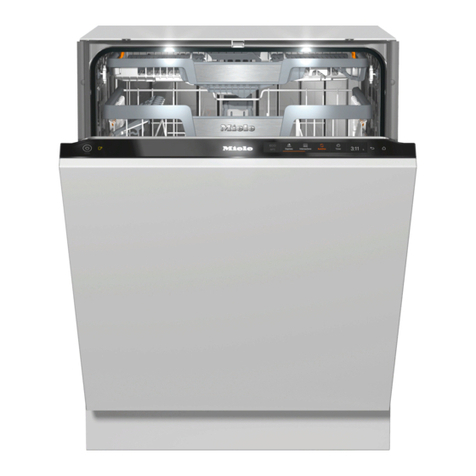
Miele
Miele HG07-W User manual

Miele
Miele 05 620 661 User manual
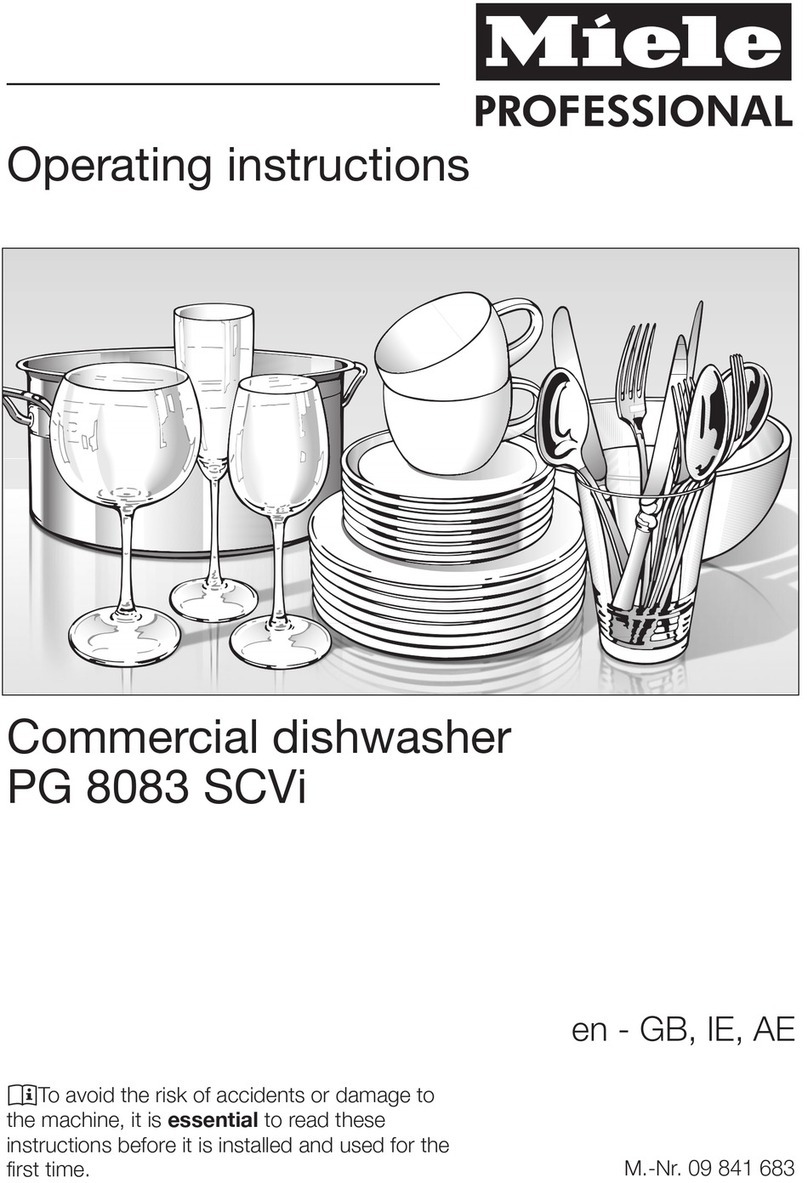
Miele
Miele PG 8083 SCVi User manual
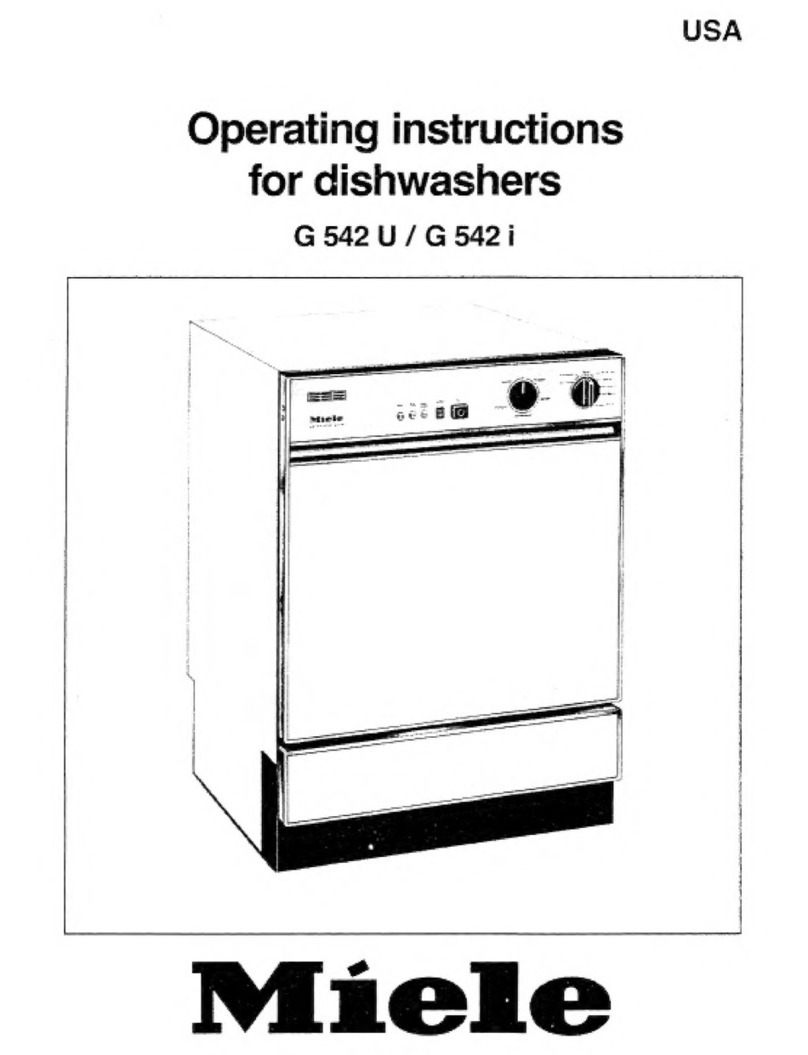
Miele
Miele G 542 U User manual

Miele
Miele G 4940 User manual
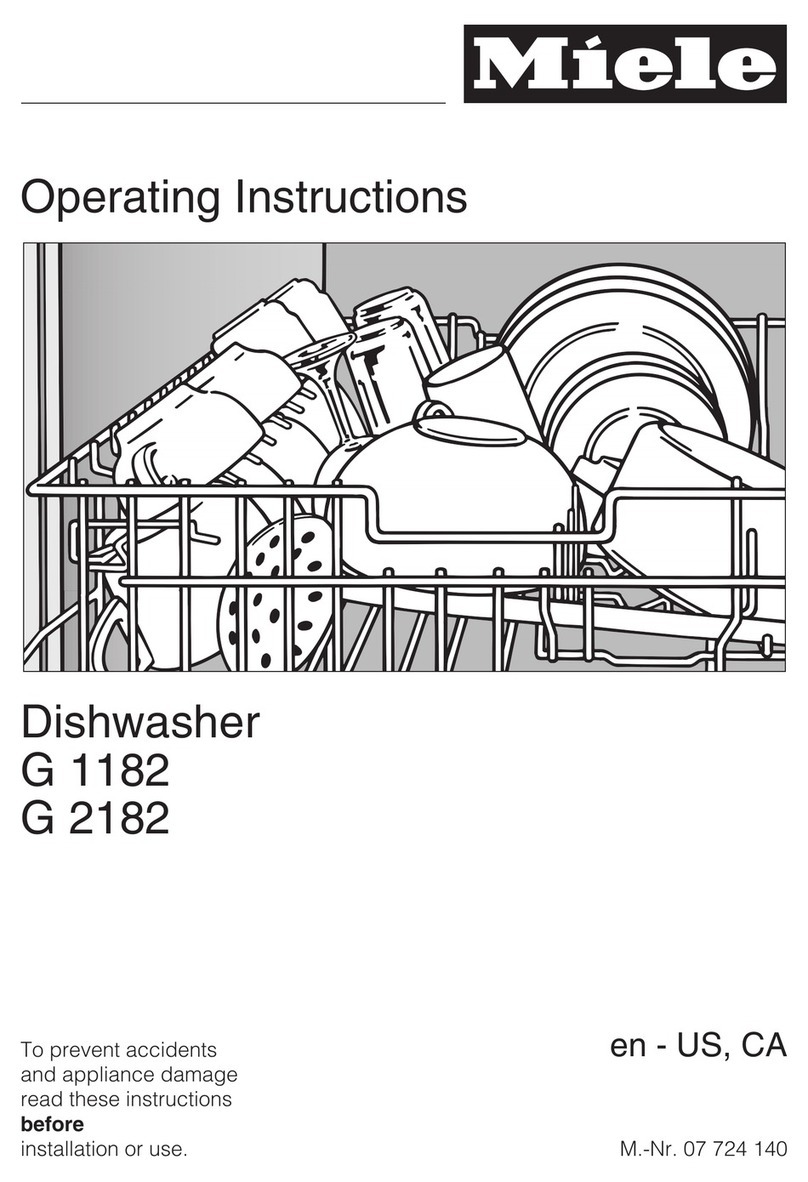
Miele
Miele G2182SC User manual
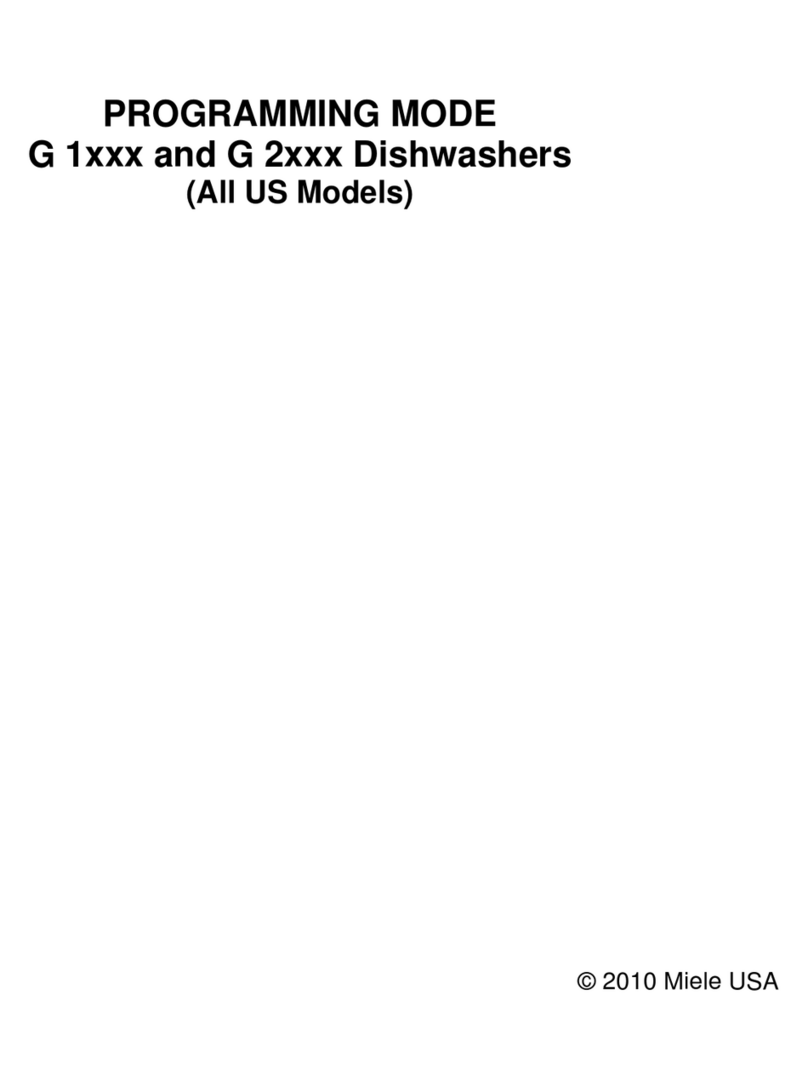
Miele
Miele G 1 Series User manual

Miele
Miele G 4948 User manual
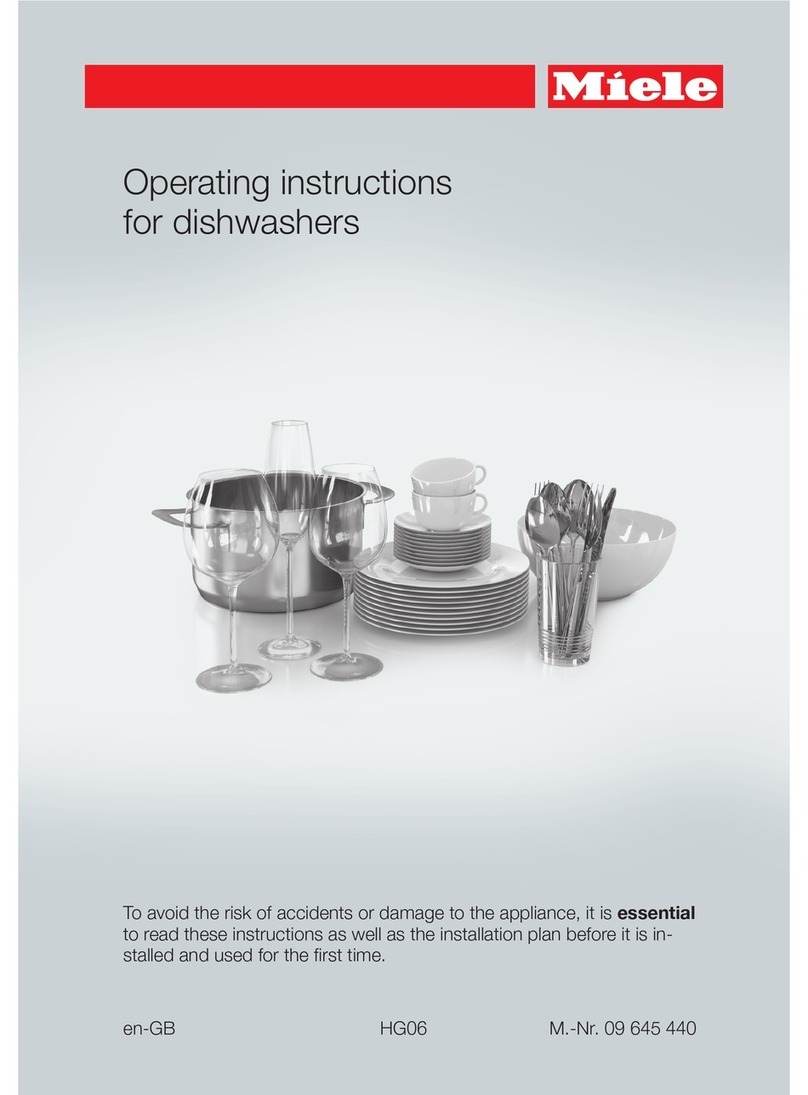
Miele
Miele HG06 User manual
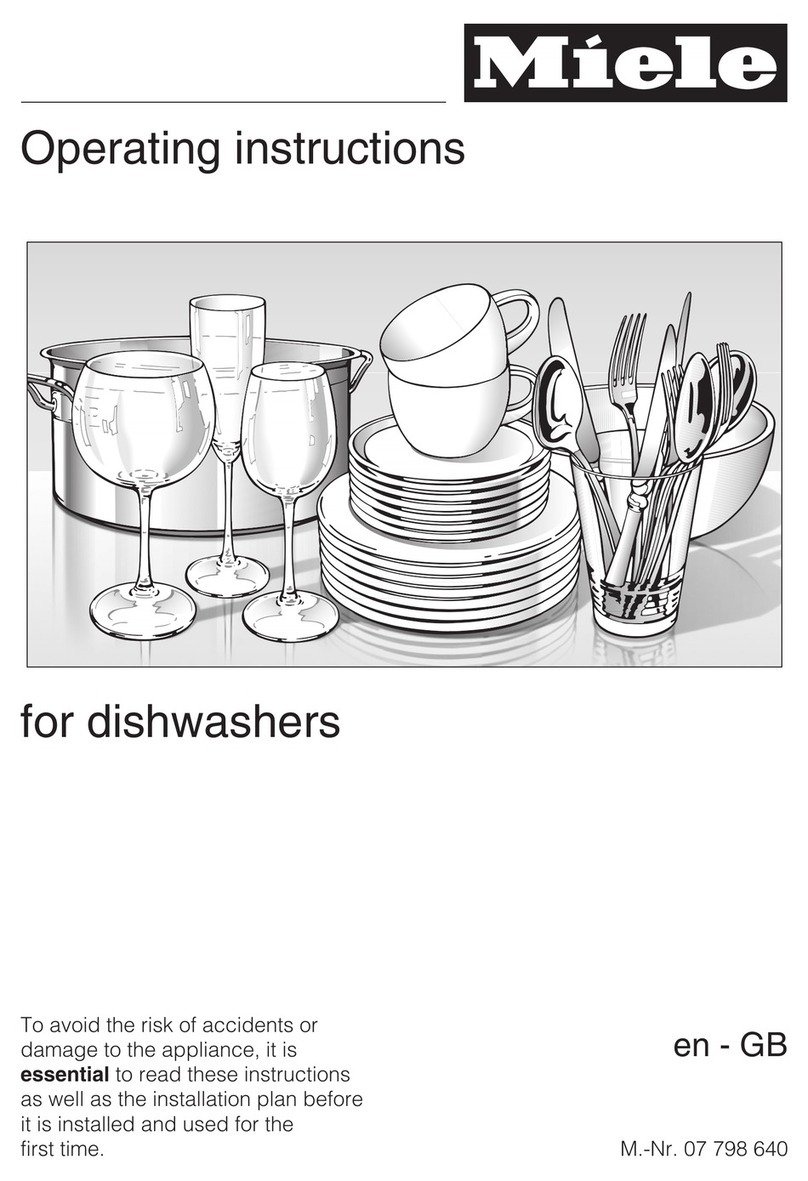
Miele
Miele G 5100 User manual
